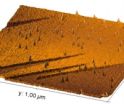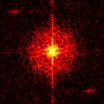(Press-News.org) In the field of nanotechnology, electrically-charged particles are frequently used as tools for surface modification. Researchers at the Helmholtz-Zentrum Dresden-Rossendorf (HZDR) and the TU Vienna were at last able to reconcile important issues concerning the effects of highly charged ions on surfaces.
Ion beams have been used for some time now for surface modification as ions are capable of carrying such high energies that a single particle alone can induce drastic changes to the surface under bombardment. Following careful examination, an international team of researchers was at last able to shed light on the reasons why sometimes craters and other times hillocks are forming as a result of this process. Their findings have recently been published in the scientific journal, Physical Review Letters.
Charge instead of speed
"If the goal is to deposit a maximum amount of energy on a tiny spot on the surface, it is of comparatively little use to simply bombard the surface with fast atoms," explains Prof. Friedrich Aumayr of the TU Vienna's Institute of Applied Physics. "Fast particles penetrate deep into the material thereby depositing their energy over a wide range." If, however, you first strip a large number of electrons from individual atoms and then allow these highly charged ions to collide with the material surface, the effects you get are quite dramatic as the energy that was previously required to ionize the atoms is now being released within a very small area of a few nanometers in diameter, and within an ultrashort time.
This can lead to melting of a very small volume of the material, loss of its orderly atomic structure, and, finally, its expansion. The large number of electronic excitations that result from the ion's interactions with the surface has a strong impact on the material and ultimately leads to the atoms being bumped out of position. The end-result is nano-hillock formation – the appearance of tiny protrusions on the material's surface. If the energy required to initiate melting of the material is insufficient, small holes or defects will form on or below the surface instead.
Elaborate experiments at the HZDR facility for highly charged ions were just as important to obtaining a detailed picture of the processes that take place at the material's surface as were computer simulations and extensive theoretical work. "At our new HZDR facility, we have the capabilities for deliberately forming nano-hillocks and nano-craters on surfaces. In close collaboration with the groups of our colleagues Friedrich Aumayr and Joachim Burgdörfer at the TU Vienna we succeeded to grasp the underlying physical mechanisms in more detail", explains Dr. Stefan Facsko. Egyptian physicist Dr. Ayman El-Said, who spent two years as a Humboldt Foundation fellow conducting research at HZDR, made substantial contributions to the current body of research in this field.
Assumptions confirmed
The scientists are calling their results the missing important piece of the puzzle to help them understand the interaction of highly charged ions with surfaces. By subjecting the sample to an acid treatment following ion bombardment, they are able to document the extent to which a surface is modified at given energies. The formation of nano-hillocks depends to a large extent on the ion beams' charge state and to a lesser extent on their velocity. The formation of craters, on the other hand, is dependent upon both the charge state and the kinetic energy of the ions. The Vienna and Dresden researchers had long suspected this and were now at last able to produce the necessary evidence obtained from their experiments conducted at the HZDR.
INFORMATION:
Publication: A.S. El-Said, R.A. Wilhelm, R. Heller, S. Facsko, C. Lemell, G. Wachter, J. Burgdörfer, R. Ritter, F. Aumayr: "Phase diagram for nanostructuring CaF2 surfaces by slow highly charged ions", in Physical Review Letters 109 (2012), 117602, http://link.aps.org/doi/10.1103/PhysRevLett.109.117602, DOI-Link: 10.1103/PhysRevLett.109.117602
Further Information
Dr. René Heller
Institute of Ion Beam Physics and Materials Research at HZDR
Phone: +49 351 260-3617
Email: r.heller@hzdr.de
Press Contact
Dr. Christine Bohnet
Press Officer
Phone: +49 351 260-2450 oder +49 160 969 288 56
Email: c.bohnet@hzdr.de
WWW: www.hzdr.de
The Helmholtz-Zentrum Dresden-Rossendorf (HZDR) conducts research in the fields of matter, health and energy. The following issues provide the main focus here:
How does matter behave in strong fields and at small-scale dimensions?
How can malignant tumors be identified at an early stage and treated effectively?
How can resources and energy be used safely and efficiently?
To answer these scientific questions, five large-scale research facilities provide, in part, unique research opportunities. These facilities are also accessible to external users.
The HZDR has been a member of the Helmholtz Association (the largest scientific organization in Germany) since January 2011. It has four locations in Dresden, Leipzig, Freiberg and Grenoble, and employs around 900 people – approx. 400 of these being scientists and doctoral candidates.
Nano-hillocks: Of mountains and craters
2012-10-01
ELSE PRESS RELEASES FROM THIS DATE:
Study reveals how memory load leaves us 'blind' to new visual information
2012-10-01
Trying to keep an image we've just seen in memory can leave us blind to things we are 'looking' at, according to the results of a new study supported by the Wellcome Trust.
It's been known for some time that when our brains are focused on a task, we can fail to see other things that are in plain sight. This phenomenon, known as 'inattentional blindness', is exemplified by the famous 'invisible gorilla' experiment in which people watching a video of players passing around a basketball and counting the number of passes fail to observe a man in a gorilla suit walking across ...
Physiological role of a novel hormone FNDC5/irisin revealed in humans
2012-10-01
Oxford, October 1, 2012 - A research team led by Dr. Christos Mantzoros, MD, PhD, at Beth Israel Deaconess Medical Center, Harvard Medical School, has published new findings elucidating the molecular and clinical role of FNDC5/irisin in humans.
Irisin is a recently identified hormone secreted from muscle cells that has been found to serve as a chemical messenger providing key exercise-induced health benefits in mice. In these earlier studies, irisin showed direct effects on 'browning' of white fat which would lead to burning of excess calories. Discovery of irisin therefore ...
Computerized osteoporosis detection
2012-10-01
A computerized approach to examining patient bone X-rays for diagnosis of osteoporosis could side-step the subjectivity associated with visual examination, according to a new research paper in the International Journal of Biomedical Engineering and Technology published in October.
Neelesh Kumar of the Central Scientific Instruments Organisation in Chandigarh, India, and colleagues recognized that the bone disorder osteoporosis is on the increase but that diagnosis using X-ray images of the patient's skeleton often lead to false positives and false negatives because visual ...
The chemical memory of seawater
2012-10-01
Water does not forget, says Prof. Boris Koch, a chemist at the Alfred Wegener Institute for Polar and Marine Research in the Helmholtz Association. Irrespective of what happens in the sea: whether the sun shines, algae bloom or a school of dolphins swims through a marine area – everything and everyone leaves biomolecular tracks. With the help of a combination of new techniques, Boris Koch and colleagues can now identify and retrace some of these. In a special volume of the open access journal Biogeosciences, these scientists report on how these analyses work and which ...
First images of Landau levels revealed
2012-10-01
Physicists have directly imaged Landau Levels – the quantum levels that determine electron behaviour in a strong magnetic field – for the first time since they were theoretically conceived of by Nobel prize winner Lev Landau in 1930.
Using scanning tunnelling spectroscopy - a spatially resolved probe that interacts directly with the electrons - scientists at institutions including the University of Warwick and Tohoku University have revealed the internal ring-like structure of these Landau Levels at the surface of a semiconductor.
The experimental challenge in the work ...
UK-led project unravels the structures of membrane proteins
2012-10-01
The European Drug Initiative on Channels and Transporters (EDICT), which comes to an end this year, focused on membrane proteins. They make up a third of all proteins in every organism and play a key role in many human diseases.
Membrane proteins are difficult to study and poorly understood, but the four-year EDICT project has enabled a major step forward in our understanding of the structures – and even more importantly the functions – of over 30 of these proteins. Bringing together over 100 researchers across 12 countries, the project has developed better and faster ...
'Green Brain' project to create an autonomous flying robot with a honey bee brain
2012-10-01
Scientists at the Universities of Sheffield and Sussex are embarking on an ambitious project to produce the first accurate computer models of a honey bee brain in a bid to advance our understanding of Artificial Intelligence (AI), and how animals think.
The team will build models of the systems in the brain that govern a honey bee's vision and sense of smell. Using this information, the researchers aim to create the first flying robot able to sense and act as autonomously as a bee, rather than just carry out a pre-programmed set of instructions.
If successful, this ...
Yearlong MAGIC climate study launches
2012-10-01
UPTON, NY - A Horizon Lines container ship outfitted with meteorological and atmospheric instruments installed by U.S. Department of Energy (DOE) scientists from Argonne National Laboratory and Brookhaven National Laboratory will begin taking data today for a yearlong mission aimed at improving the representation of clouds in climate models. The study, a collaborative effort between DOE's Atmospheric Radiation Measurement (ARM) program Climate Research Facility and Horizon Lines, marks the first official marine deployment of the second ARM Mobile Facility, AMF2, and is ...
Nothing to sneeze at: Scientists find cheating ragweed behaves better with its kin
2012-10-01
Cheating. Conflict. Competition. It may sound like a soap opera but this is the complex life of the despised ragweed plant.
And in the highly competitive fight for nutrients, researchers have found ragweed will behave altruistically with its siblings, investing precious resources for the benefit of the group.
A growing body of work suggests plants recognize and respond to the presence and identity of their neighbours and the findings, published online in the journal PLOS ONE, provide further evidence of the importance of family in preserving cooperation within and ...
Evidence-based guidelines enable optimal treatment of common low-back pain
2012-10-01
AUGUSTA, Ga. – While scientific evidence suggests that less is typically more when it comes to diagnosing and treating low-back pain in the U.S., the number of expensive imaging exams and surgeries done on patients continues to rise, researchers say.
More than 25 percent of American adults report at least one episode of acute low-back pain in the past three months and the annual total price tag is about $100 billion, according to a study in an issue of the Journal of the American College of Radiology focusing on health care reform.
"For the great majority of patients, ...


